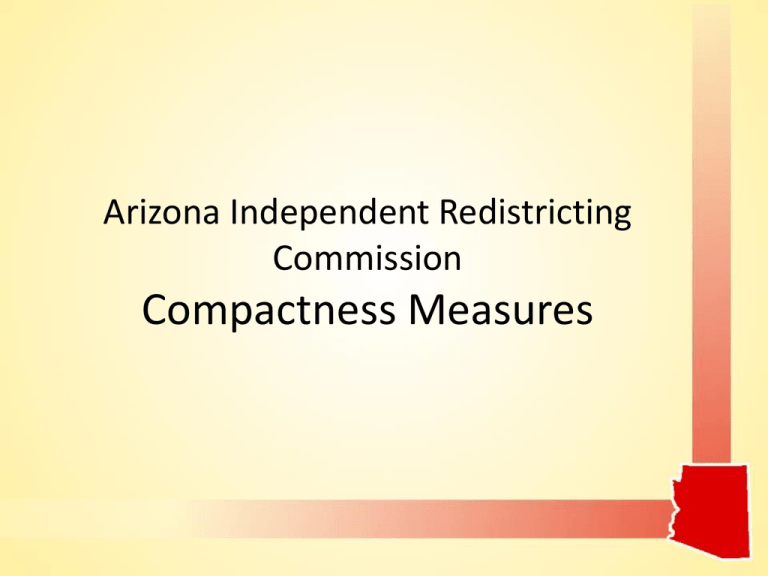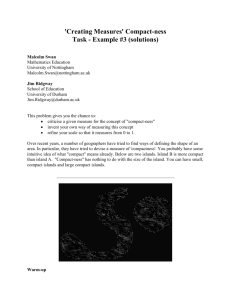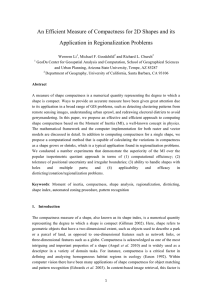Compactness Measures - Independent Redistricting Commission
advertisement

Arizona Independent Redistricting Commission Compactness Measures Why is Compactness important 2 Measurements of Compactness Perimeter Test • • The Perimeter test computes the sum of the perimeters of all the districts. The Perimeter test computes one number for the whole plan. If you are comparing several plans, the plan with the smallest total perimeter is the most compact. 3 Measurements of Compactness Reock Test • • • The Reock test is an area-based measure that compares each district to a circle, which is considered to be the most compact shape possible. For each district, the test computes the ratio of the area of the district to the area of the minimum enclosing circle for the district. The measure is always between 0 and 1, with 1 being the most compact. CD Score 1 .64 2 .55 3 .44 4 .48 5 .43 6 .47 7 .48 8 .43 9 .60 4 Measurements of Compactness Reock Test Grid CD 1 is the best under the Reock Test 5 Measurements of Compactness Reock Test Grid CDs 5 & 8 are the worst under the Reock Test 6 Measurements of Compactness CD Score Polsby-Popper Test 1 .44 • 2 .30 3 .37 4 .40 5 .28 6 .42 7 .49 8 .39 9 .59 • • The Polsby-Popper test computes the ratio of the district area to the area of a circle with the same perimeter: 4pArea/(Perimeter2). The measure is always between 0 and 1, with 1 being the most compact. The Polsby-Popper test computes one number for each district and the minimum, maximum, mean and standard deviation for the plan. 7 Measurements of Compactness Polsby-Popper Test Grid CD 9 is the best under the Polsby-Popper Test 8 Measurements of Compactness Polsby-Popper Test Grid CD 5 is the worst under the Polsby-Popper Test 9 Measurements of Compactness Population Polygon Test • • • Computes the ratio of the district population to the approximate population of the convex hull of the district (minimum convex polygon which completely contains the district). The measure is always between 0 and 1, with 1 being the most compact. The Population Polygon test computes one number for each district and the minimum, maximum, mean and standard deviation for the plan. CD Score 1 .88 2 .50 3 .37 4 .50 5 .40 6 .94 7 .82 8 .80 9 .93 10 Measurements of Compactness Population Polygon Test Grid CD 6 is the best under the Population Polygon Test 11 Measurements of Compactness Population Polygon Test Grid CD 3 is the worst under the Population Polygon Test 12 Measurements of Compactness Population Circle Test • • • The population circle test computes the ratio of the district population to the approximate population of the minimum enclosing circle of the district. The population of the circle is approximated by overlaying it with a base layer, such as Census Blocks. The measure is always between 0 and 1, with 1 being the most compact. The test computes one number for each district and the minimum, maximum, mean and standard deviation for the plan. CD Score 1 .63 2 .41 3 .17 4 .15 5 .27 6 .64 7 .45 8 .48 9 .64 13 Measurements of Compactness Population Circle Test Grid CDs 6 and 9 are the best under the Population Circle Test 14 Measurements of Compactness Population Circle Test Grid CDs 4 is the worst under the Population Circle Test 15 Measurements of Compactness Ehrenburg Test • • The Ehrenburg test computes the ratio of the largest inscribed circle divided by the area of the district. The measure is always between 0 and 1, with 1 being the most compact. The Ehrenburg test computes one number for each district and the minimum, maximum, mean and standard deviation for the plan. CD Score 1 .63 2 .39 3 .53 4 .66 5 .26 6 .39 7 .57 8 .38 9 .63 16 Measurements of Compactness Ehrenburg Test Grid CD 4 is the best under the Ehrenburg Test 17 Measurements of Compactness Ehrenburg Test Grid CD 5 is the worst under the Ehrenburg Test 18










